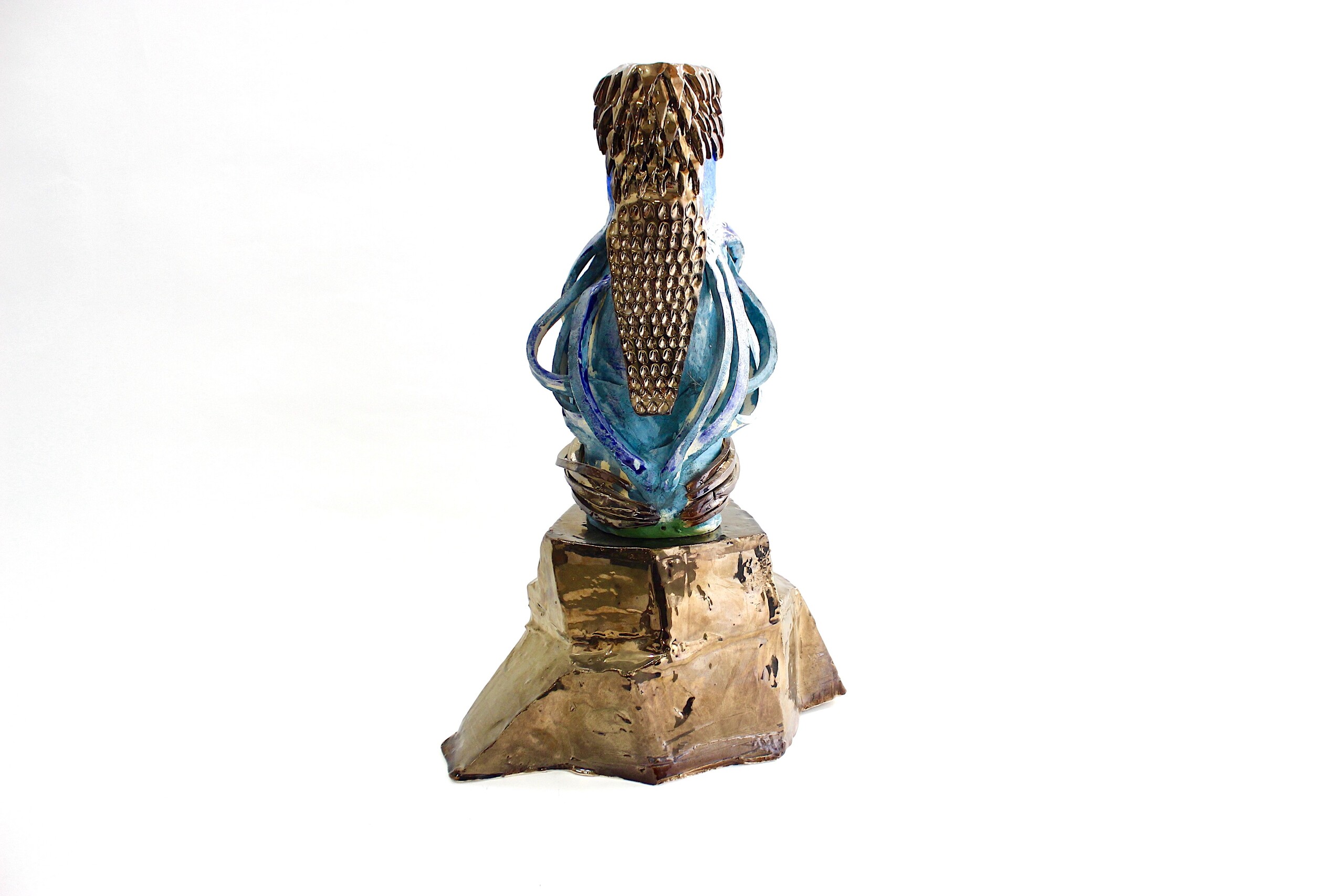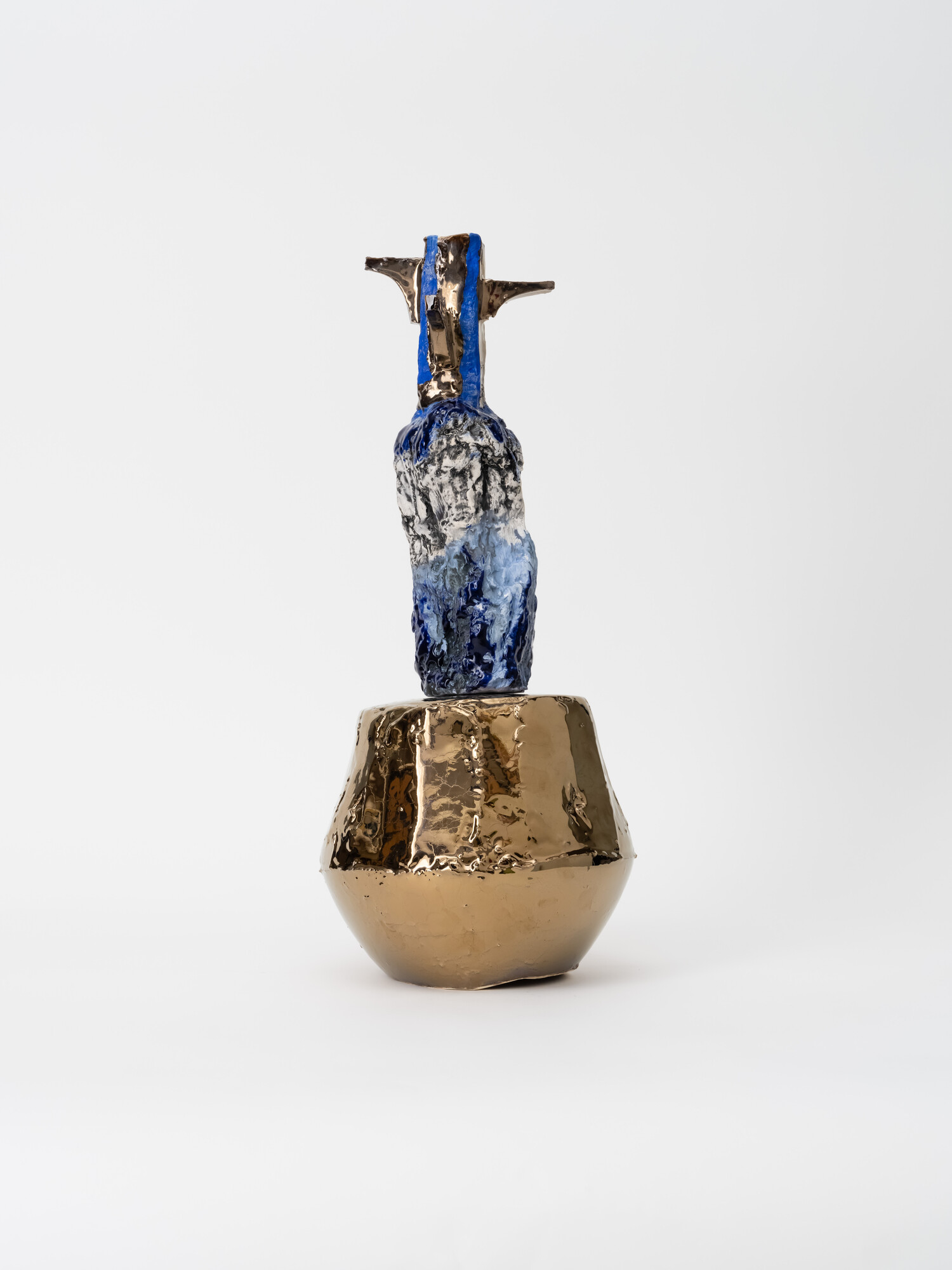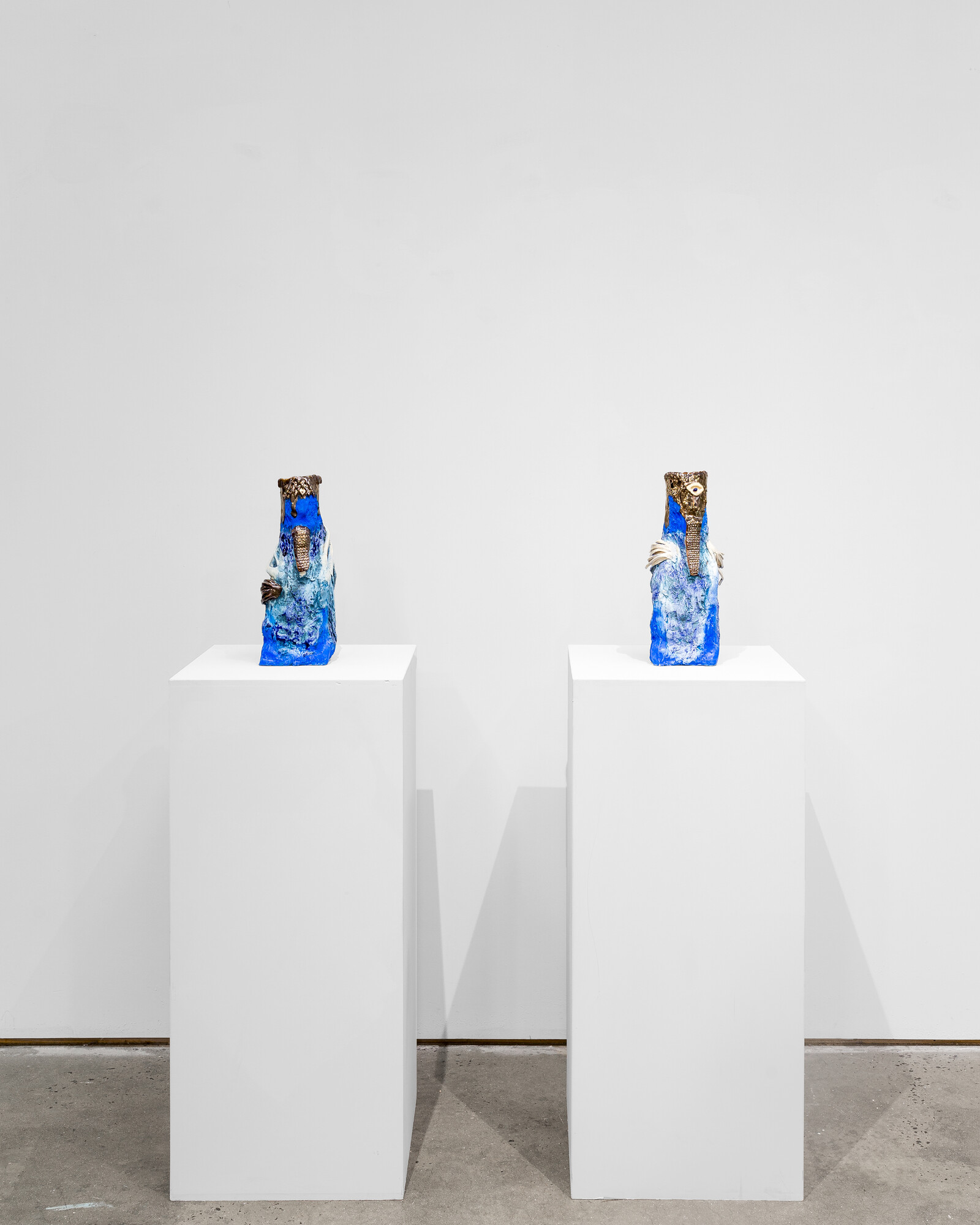Ara Dolatian: Mythos of the Island
Nicolas Hausdorf
It is only at a second glance that I realise that the current exhibition of sculpture at James Makin Gallery is a temporary burial and excavation site. I am transported back two decades to memories of daily CNN “embedded journalism” updates on the West’s last great crusade. On 10 April 2003, three weeks into the US invasion of Iraq, television audiences—still transfixed by what then appeared to be an invincible US techno- and hyperpower—watched devastating scenes of a National Museum of Iraq in Baghdad ransacked by looters while US forces stood idle. What at first looked like a spectacle of spontaneous anarchy brought about by a vacuum of power, disgruntled citizens and US army disorganization was later revealed to be no such thing: opportunistic looting in fact took place but the museum’s most prized possessions had been expertly targeted by professionals and insiders, who were well prepared to take the most valuable pieces and steer clear of worthless copies. Thus, the professional thieves used the cover of the post-invasion chaos to steal and smuggle some of the world’s oldest and most precious artefacts out of the country and proceeded to transfer them into the impenetrable, illegal international arts trade. Its flows of dark money added further fuel the dismantling of the country by a multitude of private entrepreneurial and pirating militias. In total, nine thousand to ten thousand works disappeared, but who can tell really? After all, the museum’s catalogues were strategically destroyed to make it even more difficult to allow accountability and prevent reselling on illicit markets. At the same time, the museum’s looting presented only a dramatic overture to the parallel economy of pirate trade and illegal excavations by ISIS and other actors across the destabilised country that was to ensue in the years to come, and which has been reported on by the University of Chicago’s MANTIS research team and others.

The reaction from the US to the incident epitomised the general blend of an obscenely silly surface PR and serious military strategy which characterised the entirety of the war: when asked about the looting, the neoconservative Secretary of Defense Donald Rumsfeld, one of the architects of the invasion, commented with a laconic “stuff happens”. At the same time, the war coalition’s cultural adviser and Italian diplomat Piero Cordone—who tried to stop the excavations—quickly forgot about his task after American troops “accidentally” fired on his convoy and killed his interpreter. For Iraqi citizens, in return, the ostentatious inaction of US and UK troops and the disappearance of part of their cultural heritage was utterly symbolic. Just another flower in a bouquet of contempt by the foreign invaders seeking to profane and defile the country down to the elimination of their history, as illustrated by the US construction of an airbase on top of the ancient Sumerian city of Ur. Their imagination elevated the attacks into a mythico-historical dimension of a vengeful Anglo-Israeli Leviathan eternally seeking retribution against the pentamillenary civilisation recognised as a direct successor to the eternally hated Babylon. A charge difficult to dismiss entirely: after all, had not the following and preceding years illustrated that the ransacking had been a more permanent feature of US-Israeli-sponsored warfare in the Middle East, anticipated by Ariel Sharon campaign in Lebanon and after Iraq repeated in Libya and Syria? And were not the main political proponents and supporters of those wars, the US neocons, infamous for their obscure and esoteric blend of corporate, military, religious and personal interests to which ends they deployed the US state? One can easily picture the members of this tribe gleefully showing the most valuable pieces to their visitors in vast Manhattan apartments. In private, of course.

For his latest exhibition Mythos of the Island at Makin’s gallery in Collingwood, Melbourne-based artist Ara Dolatian explicitly references the historic disaster that befell his place of birth. The Baghdad-born artist, whose family—originally from the Armenian diaspora—was displaced to Australia by the region’s troubled recent history, reconnects with his own context in recent Middle Eastern history as well as its mythical and ancient past. His sculptural work thus appears strangely suspended between those temporal poles and really outlines a voyage à l’interieur: is not the artist who wants to “explore social and political destabilisation and how it impacts culture in any form” and seeks to create a “tangible visual memory (of) lost architectural forms and vessels” really excavating himself? As spectators, we are presented with imposing objects made in clay, gold and lapis lazuli, the royal blue, itself known as a “luxury burial item found in the graves of Mesopotamia’s elites and royal family members”. They double as the ornaments of a discrete requiem and mourning for the country, which was prematurely set back and perhaps destroyed for decades and even centuries. It is no coincidence that the wealth and splendour that Dolatian references have a morbid subtext and are indicative of the region’s stolen promise. After all, as former French diplomat Bernard Cornut evoked, under conditions of independence and political stability, the land of Nebuchadnezzar with its reserves of abundant cheap oil would quickly dominate global oil trade, with the capacity to underbid any producer and thus corner the global market, granting its inhabitants unspeakable riches.

This geostrategic and economic potential, however, has proven a curse for its citizens. In Dolatian’s sculpture this tragedy is both replayed and sublimated: some of the pieces, like Waters, Nammu or Kish, evoke projectiles equipped with missile fins: as if the bombs that have pounded the country and still poison its soils with depleted uranium had been inverted and territorialised, with reappropriated payloads frozen and transformed at the moment of impact. They sit next to strangely disfigured and fragmented ornitho- and anthropomorphic deities, Hunt, Bird, and Martu, a hat tip to the acid horizon of our liquid modernity, the twentieth-century explosion of forms with its aim of radical novelty, the erasure of tradition and its inspiration in technicity. Here, Dolatian intends to show the hybridisation and evolution of the old gods that have come into contact with modernity and are forever altered.

But is it the Assyrian Gods who are transformed by the technological titans or the reverse? Perhaps the pieces capture the more general advent of a zeitgeist that seeks to turns away from a twentieth-century high modernism and its successors still dominant in contemporary art, yet somehow frequently degrading it to a form of high fashion. The latter appears to gradually exhaust itself with its aimless play and empty experimentation. In its place materialises the desire for more timeless figurative and mythical topoi. Of course, it is not that Dolatian’s works negate or escape modernity—the influence is clearly visible, some of the pieces are even explicitly modern. An and Nin are reminiscent of cosmic ur-eggs infused with neon electricity but also of a more recent legacy. They evoke the mid-century, kitschy avant-gardism of Lucio Fontana, but at the same time almost bear this legacy like a scar, as if aching to return to a more archaic and original realm of form. As artefacts that are somehow estranged from the contemporary, they perhaps also offer themselves as bearers of a promise to outlast modernity’s psycho-political war machines and claims to omnipotence. Where empires and armies are ground to dust and bleached for centuries by an eternal and relentless sun, we can imagine them prevailing, heralding Babylon’s final rebirth and triumph.
Nicolas Hausdorf is a German essayist living in Melbourne.


